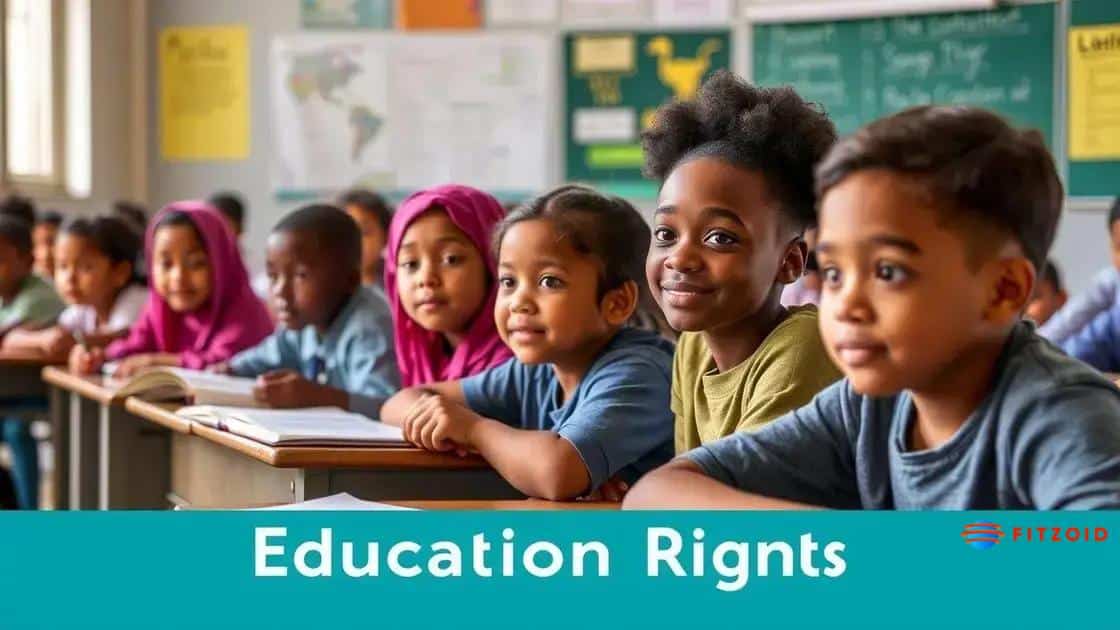Plyler v. Doe challenge: Understanding its impact today
Anúncios
Plyler v. Doe is a Supreme Court ruling that grants undocumented children the right to free public education, ensuring access and promoting inclusivity in schools across the United States.
Plyler v. Doe challenge is a significant case that highlights the educational rights of undocumented children in the United States. Have you ever thought about how this affects access to education today?
Background of Plyler v. Doe
The Plyler v. Doe case began in the early 1980s when Texas attempted to charge undocumented children for public education. This decision sparked outrage among advocates for education equality, highlighting a growing concern about access to rights for all children, regardless of their immigration status.
Anúncios
In 1982, the Supreme Court took up the case. The ruling was significant: it declared that undocumented children had the right to receive a free public education. This was a landmark moment in U.S. history as it set a precedent for the rights of undocumented individuals.
Legal Basis for the Decision
The Court’s decision was primarily based on the Equal Protection Clause of the Fourteenth Amendment. The justices argued that denying education to children because of their immigration status was discriminatory. They believed that education was essential for a person’s future, making this case crucial not only for the children involved but for society as a whole.
Anúncios
Reactions to the Ruling
The response to the ruling was mixed. While many celebrated the decision as a victory for civil rights, others expressed concerns about the implications for state resources and immigration policy. States began to react differently, with some enforcing stricter policies while others embraced the ruling.
- Supporters viewed it as a necessary step towards equality.
- Opponents raised questions about fiscal responsibility.
- Legal experts debated its long-term impacts.
This decision has continued to influence discussions on immigration and education rights. The issue of educational access remains relevant today, as debates about immigration policy evolve and more cases challenge the rights of undocumented individuals.
Legal implications of the decision

The ruling in Plyler v. Doe carried significant legal implications that still resonate today. By affirming the right of undocumented children to access public education, the Supreme Court established a crucial precedent in immigration and education law.
One of the main implications of this decision was the reinforcement of the Equal Protection Clause. The Court emphasized that no child should be denied education based on their immigration status. This principle opened doors for further discussions on the rights of marginalized groups in America.
Impact on State Funding
The ruling also raised important questions regarding state funding for education. States were concerned about the costs involved in providing education to undocumented children. However, the Court argued that education is a fundamental right and should not be compromised by financial concerns.
- States must ensure equal access to education for all children.
- Funding should be allocated to support diverse student populations.
- Every child counts, regardless of immigration status.
This decision led to a more inclusive approach in many states. As more children entered public schools, educators and lawmakers realized the importance of supporting all students to create a better society.
Challenges to the Ruling
Despite the clear implications, the Plyler v. Doe ruling has faced challenges over the years. Some states have attempted to impose restrictions on access to education for undocumented children through various legislation. These attempts have prompted further legal battles, raising questions about the extent of the Supreme Court’s authority.
Legal experts continue to debate the ongoing relevance of the Plyler v. Doe decision. It remains a key reference point in discussions about the rights of undocumented immigrants and their access to public services. The ruling emphasizes the necessity of providing education to every child, reminding us that education is vital for the growth and future of society as a whole.
| Aspect | Details | Significance |
|---|---|---|
| Case Name | Plyler v. Doe (1982) | Established educational rights for undocumented children |
| Legal Basis | Equal Protection Clause of the 14th Amendment | Prohibited discrimination based on immigration status |
| Supreme Court Decision | 5-4 ruling in favor of undocumented students | Set a precedent for inclusive education policies |
| State Reactions | Varied responses; some states embraced inclusivity, others resisted | Highlighted ongoing debates over immigration and education |
| Current Challenges | Legislative attempts to restrict access, such as in Tennessee | Potential to revisit and possibly overturn the precedent |
| Educational Impact | Increased enrollment of undocumented students in public schools | Promoted diversity and equal opportunities in education |
| Long-Term Benefits | Empowered undocumented youth to contribute to society | Enhanced social integration and economic participation |
Impact on education access
The impact on education access due to the Plyler v. Doe ruling is profound and far-reaching. This landmark decision made it clear that every child, regardless of their immigration status, has the right to receive an education. As a result, many undocumented children have been able to enroll and attend public schools.
This access has changed the perception of education in communities across the United States. Schools are now required to educate all children, ensuring that they have the same opportunities as their peers. It fostered a sense of belonging and integration among students who might otherwise feel marginalized due to their undocumented status.
Enhancing Educational Opportunities
With the ruling in place, many states revised their policies to enhance educational opportunities for undocumented students. Schools began implementing support programs tailored to meet the needs of these students. This development is essential in helping them succeed academically.
- Special tutoring and mentoring programs for undocumented students.
- Increased awareness of educational resources available to them.
- Encouragement to participate in extracurricular activities.
Moreover, schools have taken steps to create inclusive environments. Teachers and administrators are trained to understand the unique challenges faced by undocumented students. This support is vital as it helps them navigate through their educational journey.
Long-Term Benefits
The long-term benefits of increased access to education are significant. Educated individuals are more likely to contribute positively to society and the economy. By allowing all children access to education, the Plyler v. Doe ruling not only benefits those directly affected but also enriches the community as a whole.
Furthermore, this expanded access promotes a culture of acceptance and diversity within the school system. Students learn to appreciate different backgrounds and perspectives, fostering a more cohesive environment. Overall, the impact on education access has reshaped attitudes towards undocumented students and their potential contributions to society.
Responses from state governments
The responses from state governments following the Plyler v. Doe ruling have varied significantly across the United States. While some states embraced the decision and adapted their educational policies, others have reacted with caution or even resistance.
Initially, many states recognized the need to align their laws with the Supreme Court’s ruling. They implemented policies that ensured undocumented children had access to public education without discrimination. This shift led to increased enrollment of undocumented students in public schools, thus promoting diversity in classrooms.
Adoption of Inclusive Policies
States such as California and New York took proactive measures to support undocumented students. They introduced programs that facilitated school enrollment and provided additional resources. These initiatives showed a strong commitment to educational equity and the integration of all students.
- California developed outreach programs to educate families about their rights.
- New York established funding mechanisms to support schools with high numbers of undocumented students.
- Several states initiated training for educators on the challenges faced by undocumented students.
However, not all states responded positively. Some implemented restrictive measures aimed at limiting access to education for undocumented children. These policies often stemmed from concerns about financial implications or political pressures.
Legal Challenges and Ongoing Debates
In states with restrictive responses, legal challenges arose. Advocates for undocumented rights fought back, arguing that such measures contradicted the spirit of the Plyler ruling. This led to ongoing debates about the rights of undocumented individuals and the responsibilities of state governments.
The actions taken by state governments reflect broader societal attitudes towards immigration and education. In states that have embraced inclusion, there is often a strong community push for diversity and acceptance. Conversely, in states with restrictive measures, there might be a sense of fear or misunderstanding regarding undocumented populations.
Ultimately, the responses from state governments underscore the ongoing challenges in achieving educational equity for undocumented children. As public opinion continues to evolve, so too will the policies that affect these students.
Future challenges and considerations
The future challenges and considerations surrounding the Plyler v. Doe ruling remain significant as society evolves. As immigration policies change, many undocumented students face new obstacles in accessing education. These challenges can make it difficult for schools and communities to ensure that each child receives a quality education.
One major concern is the ongoing debate about funding for public schools. States with large undocumented populations may struggle to secure adequate funding to support these students. This can lead to disparities in educational resources, impacting class sizes, teacher training, and access to special programs.
Policy Changes and Legal Battles
As political climates shift, there may be attempts to revise or challenge the ruling. Some state governments may introduce legislation that limits educational access for undocumented children, creating legal battles similar to those faced in the past. Such changes could lead to uncertainty for families trying to navigate public education systems.
- Potential for new state laws that challenge the Plyler v. Doe ruling.
- Legal advocacy efforts to uphold the rights of undocumented students.
- Importance of community support in resisting negative policy changes.
Additionally, the growing emphasis on standardized testing raises concerns. Undocumented students may experience anxiety due to their immigration status, potentially affecting their performance. Schools need to be aware of this and provide mental health support to help these students succeed.
Public Perception and Advocacy
Furthermore, public perception of undocumented immigrants continues to shape educational policies. Advocacy efforts must strengthen to promote understanding and acceptance of undocumented students in schools. Schools must also engage with parents and communities to foster an environment of inclusivity and support.
Ultimately, the future of undocumented students depends on various factors, including policy developments, community support, and public attitudes. Addressing these challenges head-on is essential to ensuring that every child has the opportunity to receive a quality education, regardless of their immigration status.
In summary, the impact of Plyler v. Doe on education is significant
The ruling has opened doors for many undocumented children, providing them the right to a public education, which is essential for their growth and success. However, challenges remain as schools and communities work to ensure equitable access to education for all students.
Future challenges, such as funding concerns, potential policy changes, and public perception, can affect the educational experiences of undocumented students. Advocacy and support from teachers, parents, and communities are crucial in addressing these issues.
By standing together and promoting inclusivity, we can create a brighter future for every child, regardless of their immigration status. Educating all children not only benefits them but enriches society as a whole.
FAQ – Frequently Asked Questions about Plyler v. Doe and Education Access
What is Plyler v. Doe about?
Plyler v. Doe is a landmark Supreme Court case that ruled undocumented children have the right to a free public education in the United States.
What impact did the ruling have on education access?
The ruling ensured that all children, regardless of immigration status, can enroll in public schools, promoting inclusivity and diversity in education.
Are there ongoing challenges related to this ruling?
Yes, challenges include funding issues, potential legislative changes, and differing responses from state governments regarding educational access for undocumented students.
How can communities support undocumented students?
Communities can provide advocacy, promote understanding, and create supportive environments within schools to help undocumented students succeed.





